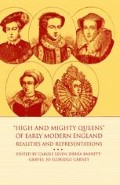Abstract
Mary Stuart acceded to the throne of Scotland as an infant in 1542. The Scots sent her to France in 1548 for her safety and education and because she was betrothed to the future King of France. Mary’s mother, Mary of Guise, who later began acting as regent in Scotland on her daughter’s behalf, died on June 11, 1560, leaving a void in the government. The Protestant Scottish nobles took this opportunity to ban the celebration of the Mass. Francis II, now husband of Mary Stuart and King of France, died six months later, on December 5, 1560. A Catholic Mary Stuart returned to Scotland, a kingdom she hardly knew, on August 19, 1561, with very few people whom she could trust to advise her.
Preview
Unable to display preview. Download preview PDF.
Notes
James Emerson Phillips, Images of a Queen: Mary Stuart in Sixteenth-Century Literature (Berkeley and Los Angles: University of California Press, 1964), p. 10;
Duke of Hamilton, Mary R: Mary Queen of Scots: The Crucial Years (Edinburgh and London: Mainstream, 1991), p. 28.
William Camden, History or Annals of England During the Whole Life and Reign of Elizabeth, late Queen thereof Complete History of England: with the Lives of all the Kings and Queens Thereof (London: Brab Aylmer, 1706), p. 396; see also Jayne Elizabeth Lewis, The Trial of Mary Queen of Scots: A Brief History with Documents (Boston and New York: Bedford/St. Martins, 1999), pp. 9–10, hereafter Trial; and Jenny Wormald, Mary Queen of Scots: A Study in Failure (London: George Philip, 1988), p. 147, hereafter Failure;
see also T. F. Henderson, Mary Queen of Scots: Her Environment and Tragedy, 2 vols. (1905; reprint, New York: Haskell, 1969), 1: p. 294.
Thomas Wright, Queen Elizabeth and Her Times; a series of original letters, vol. 1 (London: H Colborn, 1838), pp. 179, 187; and Wallace MacCaffrey, The Shaping of the Elizabethan Regime (Princeton: Princeton University Press, 1968), pp. 166, 170.
Thomas Wright, Queen Elizabeth and Her Times; a series of original letters, vol. 1 (London: H Colborn, 1838), pp. 179, 187; and Wallace MacCaffrey, The Shaping of the Elizabethan Regime (Princeton: Princeton University Press, 1968), pp. 166, 170.
Andrew Lang, The Mystery of Mary Stuart (1901; reprint, New York: AMS, 1970), pp. 117–20. See also Calendar of State Papers, Relating to Mary, Queen of Scots, 1547—1603, preserved in the Public Records Office, the British Museum and elsewhere in England, eds. Joseph Bain et al., 13 vols. (Edinburgh: H. M. General Register House, 1898–1969), 2: pp. 598–99, hereafter CSP, Scotland.
Belsey, The Subject of Tragedy: Identity and Difference in Renaissance Drama (London and New York: Methuen, 1985), p. 18.
See Sarah M. Dunnigan, “Scottish Women Writers c. 1560-c. 1650,” A History of Scottish Women’s Writing, ed. Douglas Gifford and Dorothy McMillan (Edinburgh: Edinburgh University Press, 1997), p. 19.
J. E. Neale, Queen Elizabeth I (London: Jonathan Cape, 1961), p. 109.
In Renaissance thought, reliance on fortune meant the hope for earthly prosperity rather than a Christian hope in the eternal. See H. David Brumble, Classical Myths and Legends in the Middle Ages and Renaissance (Westport, CT: Greenwood, 1998), pp. 123–26.
See James H. Averill, Wordsworth and the Poetry of Human Suffering (Ithaca and London: Cornell University Press, 1980), p. 283;
and David Simpson, Wordsworth’s Historical Imagination (New York and London: Methuen, 1987), especially pp. 160–84.
Linda Colley, Britons: Forging the Nation 1707–1837 (New Haven and London: Yale University Press, 1992);
and Gerald Newman, The Rise of English Nationalism (New York: St. Martin’s, 1987).
David Watson Rannie, Wordsworth and His Circle (New York: Putnam’s, 1907), p. 25.
See Ernst H. Kantorowicz, The Kings Two Bodies (Princeton: Princeton University Press, 1957), p. 38.
Editor information
Copyright information
© 2003 Carole Levin, Jo Eldridge Carney, Debra Barrett-Graves
About this chapter
Cite this chapter
Currie, J. (2003). Mary Queen of Scots as Suffering Woman: Representations by Mary Stuart and William Wordsworth. In: Levin, C., Carney, J.E., Barrett-Graves, D. (eds) “High and Mighty Queens” of Early Modern England: Realities and Representations. Queenship and Power. Palgrave Macmillan, New York. https://doi.org/10.1007/978-1-137-10676-6_12
Download citation
DOI: https://doi.org/10.1007/978-1-137-10676-6_12
Publisher Name: Palgrave Macmillan, New York
Print ISBN: 978-0-230-62118-3
Online ISBN: 978-1-137-10676-6
eBook Packages: Palgrave History CollectionHistory (R0)

